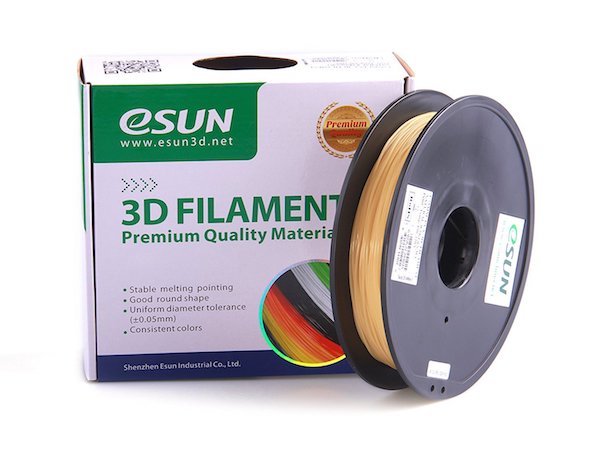Just Add Water: An Overview of Water-Soluble Filaments
Anyone who has ever been interested in 3D printing knows about ABS and PLA. After all, they are the stars of the show, so to speak. However, as in any movie or TV show, there are also some supporting characters who are less famous but are no less vital to the bigger picture. Water-soluble filaments fulfill this role in 3D printing. In this article, we go over what water-soluble filaments are, how they work, how to use them, and which brands you should buy.
What are water-soluble filaments?
As the name implies, water-soluble filaments produce prints that dissolve when soaked or submerged in water. If you have never used them before, you might ask – what will a print that degrades so easily be good for? Water-soluble filaments are primarily used to create support structures. You may be eyeing a design that has several overhanging features or have parts that are more complex than usual. If you do not want your print to fall apart before you are even done printing, then it would be a good idea to incorporate support structures into your design.
The most common compound used for water-soluble filaments is polyvinyl alcohol, or PVA. Being a polar compound, PVA completely dissolves in water, although the process may take a couple of hours. It is non-toxic and biodegradable, making it the material of choice for many industrial applications, such as textile glazing, paper coating, and contact lens solutions.
The best part about using PVA is that it breaks down into harmless and non-toxic alcohols after it dissolves in water. This means that you can safely dispose of the dissolved solution down your drain after using, although we still recommend flushing it down with liberal amounts of water to remove the alcohol-saturated solution from your drain pipes.
How do they work?
Prints with support structures made with PVA only need to be soaked in water to dissolve the support material. It can take up to 24 hours for PVA to fully dissolve. This process can be accelerated by using warm water, or by agitating the solution every now and then. You can even use a sonicator to really quicken up the dissolving process.
It is essential to use sufficient water to allow for the complete dissolution of PVA. PVA tends to become water-starved quickly and will form solid and viscous clumps under these conditions. Should this happen, mixing the solution or manually removing the support material using pliers are easy remedies. You might have to experiment a little to get the perfect ratio of water to PVA material.
How do you use water-soluble filaments?
PVA in particular works really well as a support material in tandem with PLA since they print at practically the same temperature range. If you are printing with PLA and will need to provide support structures, then PVA is by far your best choice. It is also possible to use PVA in tandem with other filaments, such as Nylon or TPU, but this may not be as easily done as with PLA. In such cases, you may want to consider other materials for support structures such as HIPS.
Since PVA will be printed simultaneously with PLA, you will need to use a printer that is capable of dual extrusion. If this is something that you do not have right now, then we recommend that you get an upgrade. Dual extrusion printers not only allow you to print designs with support structures, but you can also make prints using two filaments with different colors. The upgrade will definitely be worth it as it opens up a whole new dimension of 3D printing.
A temperature of 185 °C to 200 °C works best when printing PVA in tandem with PLA. PVA tends to break down rapidly at too high temperatures, so make sure that you do not go over 200 °C. At extremely high temperatures, PVA undergoes pyrolysis, the products of which cannot be removed by high temperature treatment. Removing burned PVA may require some heavy drilling, or you might have to replace your extruder altogether, so you will have to be extra careful.
A heated bed is not necessary when printing with PVA, but it will help in ensuring better adhesion for both PVA and PLA. We recommend using a heated bed at a temperature of 45 °C to 60 °C. If you are not using a glass heated bed, then a layer of blue painters’ tape or glue stick applied to the surface should significantly aid adhesion. To reduce warping, you may set the bed temperature a little on the high side during the first few layers and gradually decrease as the print progresses.
PVA is quite soft and fragile at high temperatures, so we recommend printing at low speeds. You may start at a very low setting of 30 mm/sec and try to work your way up. To quicken up the cooling of the print, you may use a cooling fan at 50% setting.
What are the best brands of water-soluble filaments?
Being fairly common, there are currently a lot of choice of water-soluble filaments in the market. We highlight the best ones in terms of price and performance below so you will not need to spend unnecessary time choosing.

The PVA filament from the reliable GizmoDorks brands is a good place to start. Coming from a well-known filament manufacturer, this PVA filament will likely have good quality and consistency. The GizmoDorks PVA filament is available in standard 1.75mm and 2.85mm diameters, and are sold in 0.5kg spools.

The PVA filament from eSun is also another popular choice amongst 3D printers. The filament is pretty much within the price range of other brands, and many users have reported great performance and ease of use with it. It is available in 1.75mm diameter and in 0.5kg spools.

SainSmart also sells its own version of a no-frills PVA filament. It has all the usual benefits of PVA as a support material and has good compatibility with a wide range of standard 3D printers. Users of this filament have said that it detaches very easily from the PLA, making it easier and quicker to do post-processing dissolution. The SainSmart PVA filament is available in 1.75mm diameter and in 0.5kg spools.
Finally, the Hydrofill Water Soluble Filament from AirWolf 3D is probably the fanciest entry in this selection. This filament was designed to withstand higher temperatures, so it may be used in tandem with either ABS or PLA. It still readily dissolves in water, so you will not need to buy any other solvent (unlike HIPS). Given its wide printing temperature range, we imagine that you can even use this filament to make support material for other filaments, such as Nylon. It is a little more expensive than the standard PVA filaments, but it opens up a world of possibilities in terms of material compatibility.
The final word
Water-soluble filaments may not be the star of the show, but there is no doubt that they are an essential ingredient when printing highly complicated 3D designs. We consider them specialist filaments, in that they only serve one purpose but perform its objective really well. If you are planning to print complicated designs or designs with long overhangs, then you might have to start learning how to use water-soluble filaments.
It might take some tweaking and some experimentation before you get the hang of working with water-soluble filaments, but they are well worth the effort given the number of designs that you will suddenly be able to make. To top it all off, using water-soluble filaments makes the task of removing support material practically effort-free, on top of being environment friendly. If your goal is to up your 3D printing game, then we suggest buying your first spool of water-soluble filaments and going to town with it.






